今天是复活节前圣周四,纪念主最后的晚餐。 周四最后的晚餐,周五主受难日,和圣周六晚间的守夜礼被称为“Easter Triduum", 三日庆典。
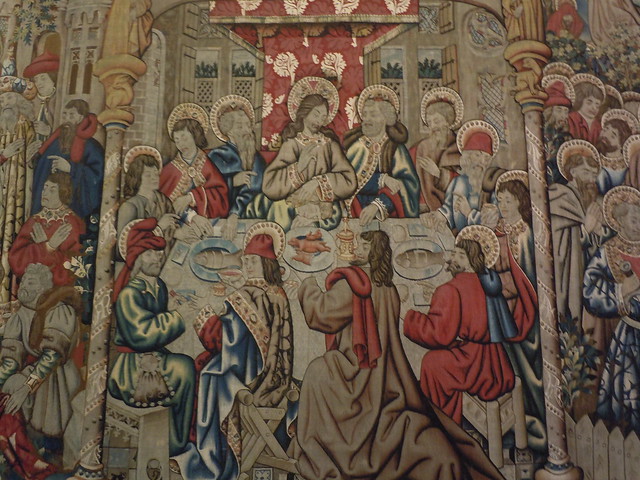
这幅挂毯的照片是我在梵蒂冈博物馆拍的。最后的晚餐,天主如此爱了世人,不惜屈尊就卑,降生成人,祂分享了我们的人性,也让我们分享祂的神性,收获那一份永恒不变舍己的爱。在逾越节最后的晚餐,祂拿起酒杯,祝圣了,说“这是我的血,新而永久的盟约之血,为你们和大众所倾流。。。”There is no greater love than to lay down one's life for one's friends.
最后的晚餐建立圣体圣事,此后的每一场弥撒都称为主的晚餐the Lord's Supper,it is the sharing on the table that is the ultimate goal. We receive His Body, Blood, Soul and Divinity. 有一次我梦到祂对我说:“I know your cup, I went through the same, I am always with you.” 从此我每次领圣体圣血多了许多感动。是呀,主耶稣在山园祈祷,曾说:“父啊,一切为你都可能:请给我免去这杯吧,但是不要照我所愿意的,唯照您的意愿成就吧!” 我想我们把自己的杯倒空,才更多接受祂的杯爵,蒙爱的生命,“福杯满溢”。
下面由网上收集来一些最后晚餐的名作。
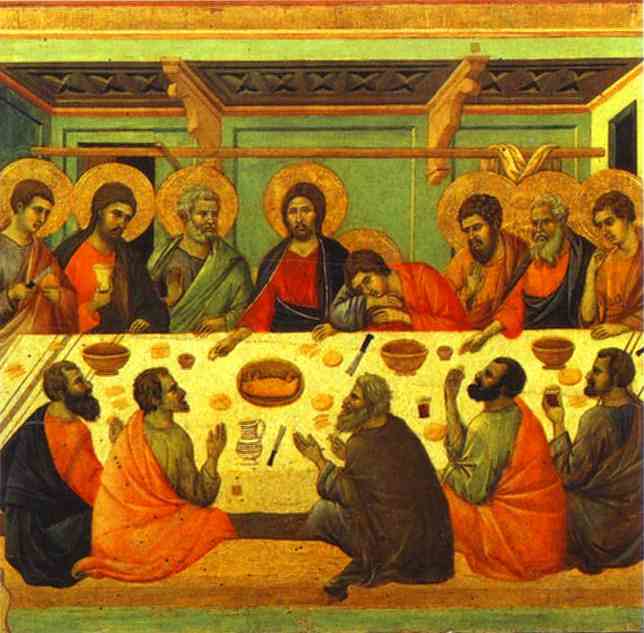
1. Duccio's Last Supper(1308-11)
This dramatic gathering has been a source of inspiration for the visual arts. The first paintings of The Last Supper were quite static - as can be seen in the works of Duccio (1308-11) and Ghirlandaio (1480). All figures are nicely seated in their chair, despite the fact that they have just learned of their master's coming betrayal.
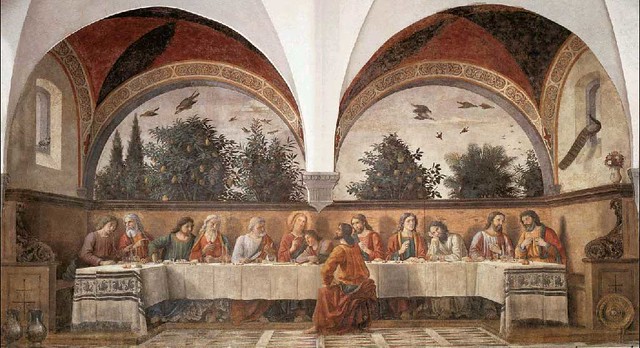
2 Domenico Ghirlandaio's Last Supper(1480)
A difficult problem for all painters of the tableau is the grouping of the figures. Duccio chose a reasonably credible one: everyone is seated around a table. A drawback of this grouping is that the faces of some of the followers are not visible. Ghirlandaio has them seated behind a long table opposite the traitor Judas, who sits alone.
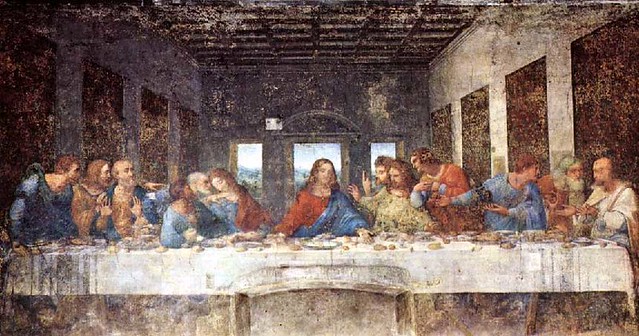
3.Leonardo da Vinci's Last Supper(1495-98)
Leonardo da Vinci effected a breakthrough with his Last Supper (approx. 1495-98). Not only is Judas fully included in the group, but the figures are engaged in lively interaction. Da Vinci's fresco inspired numerous Renaissance artists and Baroque painters. Despite many restorations, the most recent in 1999, the work is in bad condition, due to the technique used on the wall, which has insufficient sticking power. In addition, the hall was used as a stable for some time, and bombed during World War II.
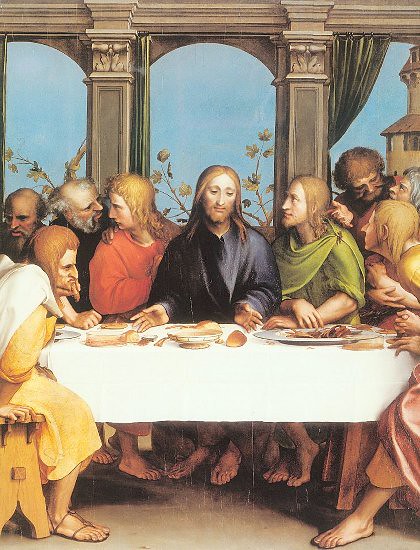
4. Hans Holbein the Younger(1524-25)
Three disciples are missing from Holbein's painting. They may have been lost when the work was damaged during the Reformation's Iconoclasm in Basel. At the same occasion, Jesus' head was sawed from the altar piece (to be put back later).Holbein chose approximately the same grouping as Leonardo da Vinci (his version), but used a smaller table and different facial expressions. A common aspect of both paintings is Peter whispering in John's ear.Panel made of lime tree wood.
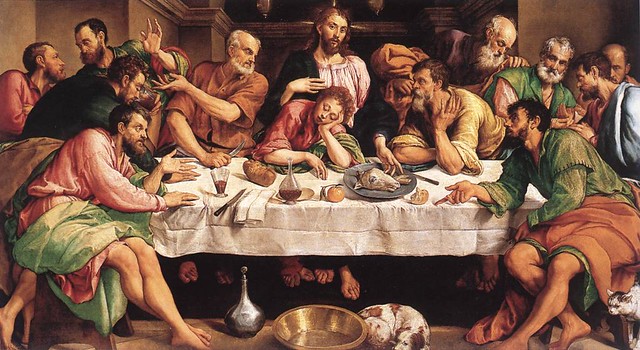
5. Rome Jacopp Bassano1542; Oil on canvas; Galleria Borghese, Rome
Jacopo Bassano's Last Supper is one of the masterpieces of 16th-century Italian painting. Instead of the elegant grouping of figures in Leonardo's painting, which inspired it, this dramatic scene features barefoot fishermen at the crucial moment when Christ asks who will betray him, and the light passing through a glass of wine stains the clean tablecloth red.
Recent restoration has only now revealed the extraordinary original colours, which had been heavily painted over in the 19th century, when the emerald green and iridescent pinks and oranges were not in fashion.
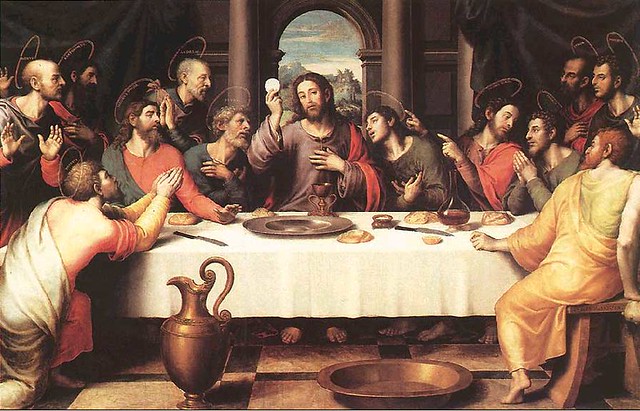
6.Juan de Juanes (1560)
A harmonious painting by the Spanish painter Juan de Juanes. Strangely enough the faces of most disciples seem to radiate mostly adoration – and this while they have just heard that their master is about to be betrayed. In the front right, the traitor Judas, for better recognition he has been equipped with a money pouch.
In the foreground a bowl for washing feet before supper.
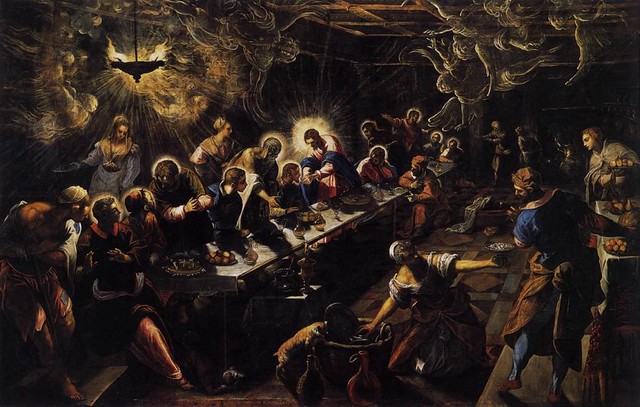
7. II Tintoretto(1594)
Tintoretto created a special atmosphere by using two light sources, darker colors and transparent, hovering angels. The angels add a supernatural touch to the painting.
Tintoretto's studio was authorized to produce several large canvasses for the newly finished San Giorgo Maggiore church in Venice. The old master would have left most of the work in the hands of his assistants, but it is certain that he made three of the canvasses himself. This Last Supper is one of them.
All disciples have a halo, except Jude – he's kneeling at the far side of the table.The lines of the table, the pattern on the floor and the wood in the ceiling create a linear perspective. That makes the painting stand in the tradition of Da Vinci's Last Supper.
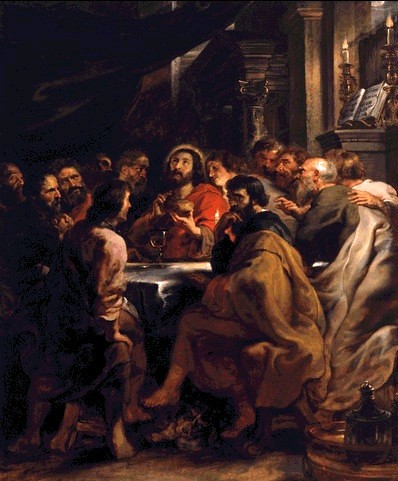
8.Peter Paul Ruben's last supper(1632)
This is one of Rubens's versions of the Last Supper. It shows Judas looking away, absent-mindedly, as the others are shocked to learn about the pending betrayal.
The painting was originally an altar-piece in the Saint Rombout Church in Mechelen. Two pre-studies are known – one in Moscow, the other in a private collection.
The Last Supper最后的晚餐(三日庆典之一)
京燕花园 发表评论于
回复南山松的评论:
亲爱的松松妹妹,千百年来心灵的圣餐激起创作源泉。。。
让我们的餐桌充满欢声笑语,亲朋好友聚首,复活节快乐o(^_^)o
亲爱的松松妹妹,千百年来心灵的圣餐激起创作源泉。。。
让我们的餐桌充满欢声笑语,亲朋好友聚首,复活节快乐o(^_^)o
南山松 发表评论于
谢谢燕子姐的分享和介绍,每幅作品都各有特色。
复活节快乐!
复活节快乐!
京燕花园 发表评论于
回复tern2的评论:
亲爱的燕鸥妹妹,抱抱!全家复活节快乐,今年你家小小鸥和我家大宝展翅高飞,上天引领照看他们~~~爱你们(~_~;)
亲爱的燕鸥妹妹,抱抱!全家复活节快乐,今年你家小小鸥和我家大宝展翅高飞,上天引领照看他们~~~爱你们(~_~;)
京燕花园 发表评论于
回复安娜晴天的评论:
亲爱的晴妹和小宝贝安娜,这些大师的作品不仅是艺术灵感,也实实在在彰显圣灵做工,他们获得了这样艺术表达的天赋。真巧想到tern妹妹的女儿,你家安娜和我家雪儿都很会画画,大宝画的比较粗线条,愿孩子们在心智上慢慢增长。
你在我心,主佑平安,圣母抱抱,主的晚餐滋润心田。(~_~;)
亲爱的晴妹和小宝贝安娜,这些大师的作品不仅是艺术灵感,也实实在在彰显圣灵做工,他们获得了这样艺术表达的天赋。真巧想到tern妹妹的女儿,你家安娜和我家雪儿都很会画画,大宝画的比较粗线条,愿孩子们在心智上慢慢增长。
你在我心,主佑平安,圣母抱抱,主的晚餐滋润心田。(~_~;)
tern2 发表评论于
亲爱的燕子,复活节快乐!
安娜晴天 发表评论于
最后的晚餐,不同的画家,时代和作品,主题是相同的, 内涵也是相同的。
谢谢燕儿如此用心的文章,主佑平安, 我们一起迎接复活节。
来自罗马最美好的祝福!
谢谢燕儿如此用心的文章,主佑平安, 我们一起迎接复活节。
来自罗马最美好的祝福!
登录后才可评论.